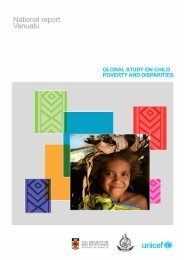A Strategic Assessment of the Children's Services Industry
A Strategic Assessment of the Children's Services Industry
A Strategic Assessment of the Children's Services Industry
- No tags were found...
You also want an ePaper? Increase the reach of your titles
YUMPU automatically turns print PDFs into web optimized ePapers that Google loves.
STRATEGIC ASSESSMENT OF THE CHILDREN’S SERVICES INDUSTRY4 Mixed markets in children’s services4.1 Market mechanisms in social policyThe issue <strong>of</strong> ‘mixed markets’ is critical to a strategic assessment <strong>of</strong> <strong>the</strong> children’s servicesindustry in Australia. In this country, as in <strong>the</strong> UK, Canada and USA, centre-based child careis provided by both for-pr<strong>of</strong>it and non-pr<strong>of</strong>it providers. As discussed in Section 1, most careand education in Australia is provided by State government or non-pr<strong>of</strong>it providers. It is onlyin <strong>the</strong> long day care sector that for-pr<strong>of</strong>it providers predominate, accounting for some 73 percent <strong>of</strong> services across <strong>the</strong> country (SCRGSP, 2008). There are significant differencesbetween <strong>the</strong> States: Queensland has <strong>the</strong> highest proportion <strong>of</strong> for-pr<strong>of</strong>it care (83 per cent) andTasmania <strong>the</strong> lowest (29 per cent). The national figure is broadly similar to <strong>the</strong> proportion <strong>of</strong>for-pr<strong>of</strong>it child care in <strong>the</strong> USA and UK. The exceptional feature <strong>of</strong> <strong>the</strong> Australian market isits high level <strong>of</strong> concentration in <strong>the</strong> hands <strong>of</strong> a single owner. While <strong>the</strong>re are no <strong>of</strong>ficialfigures, a single company is reported to own up to twenty-five per cent <strong>of</strong> all Australian longday care places. This represents a level <strong>of</strong> concentration <strong>of</strong> child care centre ownershipunparalleled in o<strong>the</strong>r countries. In <strong>the</strong> UK, <strong>the</strong> largest 40 providers toge<strong>the</strong>r own about 10 percent <strong>of</strong> all places (Pricewaterhouse Coopers 2007; Cohen and Harker 2006). In <strong>the</strong> USAnational chains collectively own 13 per cent <strong>of</strong> all centres (Sosinsky et al. 2007).Market strategies in early childhood are closely associated with <strong>the</strong> English-speaking liberalmarket economies. Although several European countries have long histories <strong>of</strong> private (i.e.non-state) involvement in community services, <strong>the</strong>se services are generally owned by cooperatives,religious groups and similar not-for-pr<strong>of</strong>it bodies. The only Continental Europeancountry to have made a major foray into market provision <strong>of</strong> ECEC is <strong>the</strong> Ne<strong>the</strong>rlands. Thesystems regarded as being <strong>of</strong> <strong>the</strong> highest quality internationally (Sweden and Denmark) arealmost entirely based on public provision; <strong>the</strong>re is some private, non-pr<strong>of</strong>it provision, but forpr<strong>of</strong>itsplay a negligible role. European governments that provide educationally-orientedservices for preschool aged children rely overwhelmingly upon public (government) andprivate non-pr<strong>of</strong>it services.The market model in early childhood has attracted considerable international attention inrecent years. For example, in 2006, <strong>the</strong> journal Children in Europe devoted a special issue to<strong>the</strong> <strong>the</strong>me, ‘Managing <strong>the</strong> Mix: Public and Private Sectors in Early Childhood <strong>Services</strong>’. Ayear later, researchers at <strong>the</strong> University <strong>of</strong> East London formed <strong>the</strong> Centre for <strong>the</strong> MixedEconomy in Child care:• To generate greater knowledge about early childhood education and care provisionin countries which employ mixed economies <strong>of</strong> welfare and education services.• To explore <strong>the</strong> contribution to young children’s well being within mixed economies<strong>of</strong> child care.• To develop an international and multi-disciplinary approach to exploring mixedeconomies <strong>of</strong> child care.4.2 Markets in human servicesThe appeal <strong>of</strong> markets in human services is part <strong>of</strong> a broader suite <strong>of</strong> changes in state-societyrelations, particularly in English-speaking countries. Similar developments have occurred ino<strong>the</strong>r human services including aged care provision, hospitals, disability services and prisons.In considering <strong>the</strong> impact <strong>of</strong> <strong>the</strong> mixed market on Australian children’s services, it is wor<strong>the</strong>xamining <strong>the</strong> reasons for <strong>the</strong> switch from exclusive support <strong>of</strong> non-pr<strong>of</strong>it providers (<strong>the</strong>bipartisan position in Australia until <strong>the</strong> early 1990s) to support for a mixed market. Private32
















